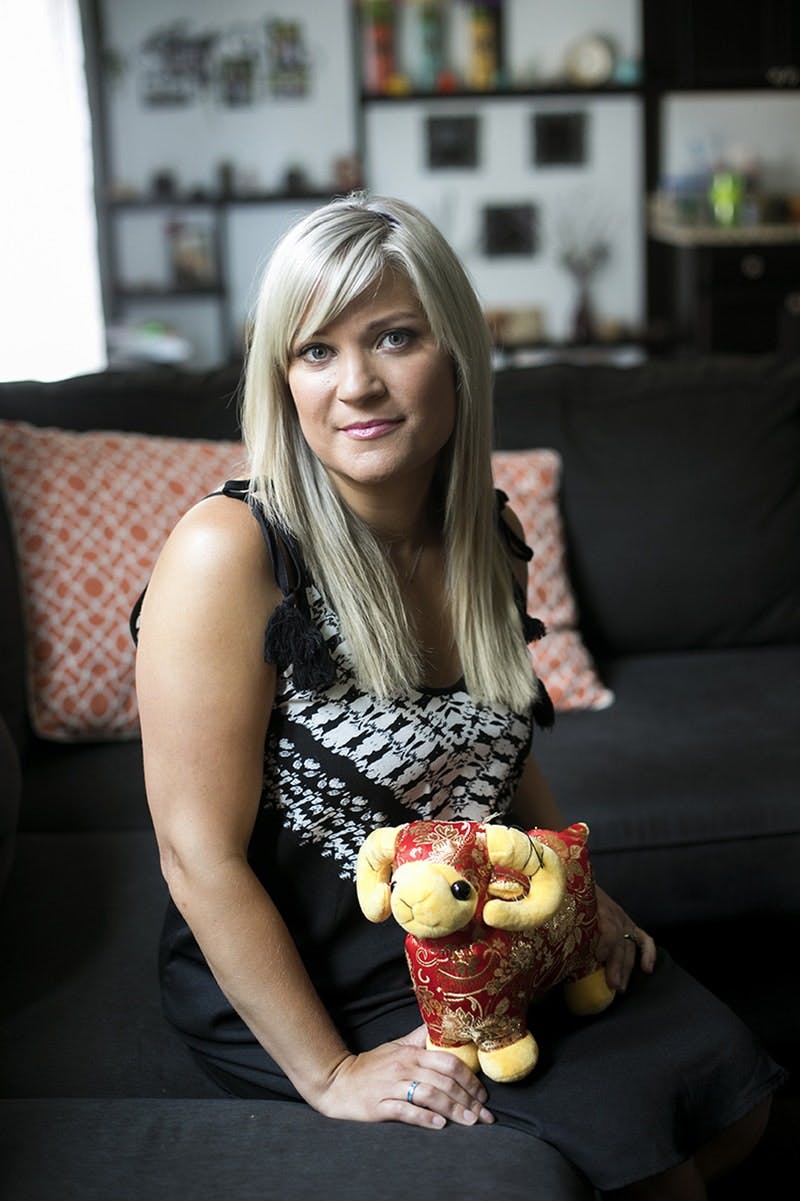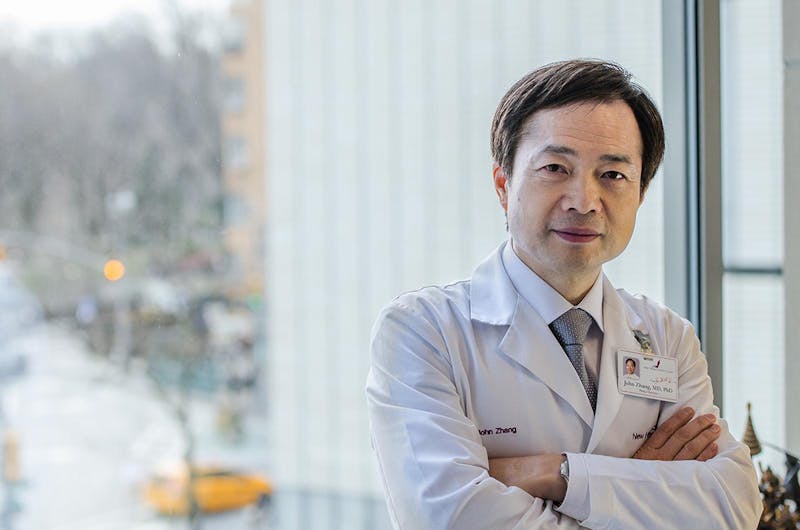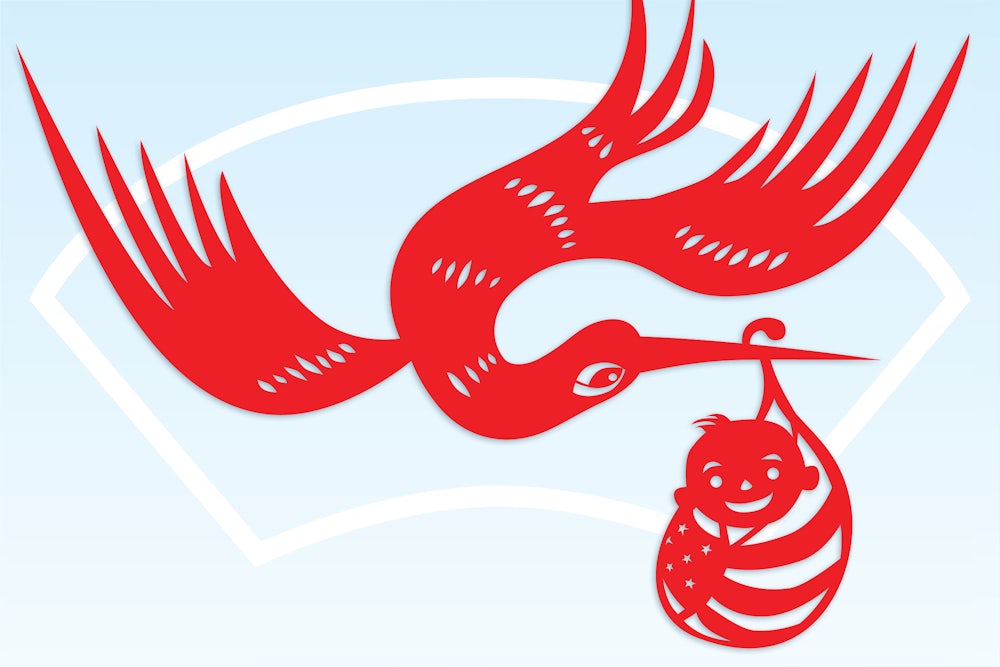The New Hope Fertility Center occupies two floors in a sleek office building across from Central Park, a block from the Trump International Hotel. Upstairs, couples who want children but are struggling to conceive sit in a well-appointed waiting room. On the wall, an LCD monitor cycles through a presentation of the clinic’s specialties: in vitro fertilization, egg freezing, genetic testing. Some of the couples, though, are pursuing a different and controversial reproductive service: surrogate pregnancy.
One flight down is a separate waiting room, both smaller and louder. “Carriers”—the women who will carry the babies for the would-be parents upstairs—watch as their own children frolic in a small, glass-walled playroom. Toddlers climb over soft blocks, roll around on rubber mats, and clutch stuffed animals. Children are not allowed on the top floor: Their presence might upset clients who are unable to conceive. But downstairs, children are a credential. They offer proof that a carrier can do her job.
Because paying someone to work as a surrogate is illegal in New York, many of the carriers come from poorer parts of the United States: Kentucky, Ohio, Tennessee, Pennsylvania, Alabama, North Carolina. Reproductive labor is a growth industry, and the workers downstairs are lining up to apply for the job. Upstairs, by contrast, the wealthy couples who will employ them often come from China, one of the fastest-growing markets for surrogate pregnancies. No one knows precisely how many Chinese citizens travel to the United States each year for surrogacy, but fertility specialists say the demand is skyrocketing. “I’ve never seen anything like it,” John Weltman, the founder of Circle Surrogacy, told CNN. “It’s like an explosion.” Fertility Source, a California agency, has hired a full-time employee to handle Chinese travel and translation. “Everyone is doing that,” says Gail Sexton Anderson, who runs Donor Concierge, an organization in California that connects carriers and families.
The influx of Chinese citizens seeking surrogates in the United States reflects, in part, the growing wealth and mobility of urban professionals in China. It has also been spurred by China’s decision to rescind its One Family One Child policy last year, allowing straight, married couples to pursue larger families. But it can take months to get into a fertility clinic in China, and both egg donation and surrogacy remain illegal. At the same time, countries like Thailand and India began to prohibit foreigners from hiring surrogates or outlawed the practice altogether. So Chinese couples in search of a surrogate followed the inexorable logic of globalization: They went looking for a ready supply of labor overseas.
With surrogacy banned throughout the EU and heavily regulated in the U.K., Canada, and Australia, the best source of “carriers” became the United States. Americans are accustomed to the idea of paying for cheap goods made in China. But in this case, money flowed out of China and into America. Agencies sprang up across China promising to help Chinese parents find blonde, blue-eyed American women to bear their children. “They basically do everything,” says Gloria Li, the Asia specialist for Donor Concierge. “Transportation, translation, help you to find a clinic, make the appointment for you. When you have the baby, they even provide a house in the United States where you can stay—all in one package.” At the very moment when Donald Trump is vowing to take a hard line with China and to bring working-class jobs back to America, Chinese couples are employing American women to perform the world’s original form of labor.
Andrea is five-foot-two and weighs 135 pounds. She is not religious but is “into signs.” She grew up in a suburb of Cleveland, where she still lives. She is 32 and has two sons, ages ten and twelve. They like video games. (“Dude, I don’t know if I can play!” she tells them when they interrupt a phone call to ask her to join them.) When her dachshund barks, she treats him with the same amiable patience. (“One minute, boy!”) Andrea got married last year to a man whom she had been dating for five years. He is older and has a 17-year-old daughter of his own.
Andrea has carried twins for a Chinese couple before; when we meet, she is pregnant with her third surrogate child. The money she earns is “not a survival thing,” she says, but it has improved her life. She got the idea after seeing the movie Baby Mama, with Tina Fey and Amy Poehler. At the time, she was working as the general manager of a men’s hair salon. She found the job exhausting; some weeks, she was working every day. When Andrea’s brother and his wife were struggling to get pregnant, she offered to carry a child for them; they declined. That’s when Andrea realized that she wanted to become a surrogate. She went online and found an agency in New Jersey called New Beginnings, which refers clients and surrogates to New Hope. She filled out a questionnaire, and they contacted her the next day.

It took five months for New Beginnings to place Andrea with a family. In July 2013, she flew to New York to meet with the agency’s surrogacy coordinator and be evaluated by a psychologist. “They give you a really long questionnaire and the answers are: Never, Sometimes, or All the time,” Andrea tells me. “Would I want to keep the baby? Do I drink or do drugs? How much? How often? If I get mad, what do I do? They ask 20 different ways if you are thinking of killing yourself.” Andrea was proud to hear that she was “one of the best surrogates that the psychiatrist had ever met.”
Two months later, Andrea returned to New Hope to have an embryo from the “intended parents”—known as I.P.s—transferred into her uterus. For weeks after the procedure, she gave herself progesterone injections. (“My husband can’t handle needles, so I did it all myself.”) Still, the transfer failed. So did the next four. The process was “exhausting,” she says. “It took a whole year.” Finally, the I.P.s switched to using an egg donor. On September 11, 2014, the doctors at New Hope transferred male twins into Andrea. She knew that the twins took when she started feeling “emotional.” (“A Whitney Houston song would come on the radio and I’d cry.”) After her doctor confirmed that the fetus had a heartbeat, she received her first stipend. The same day, she gave the hair salon two weeks’ notice.
Gestational surrogacy costs around $100,000. Of that, surrogates take home an average $30,000 to $35,000, with a bonus if they carry multiple pregnancies. The remainder of the money goes to the middlemen involved in the transaction, covering agency fees, legal fees, counseling services, and health insurance. If you do the math, the standard surrogacy fee works out to around $5 per hour for the duration of the pregnancy.
Surrogates are often paid higher fees to work with foreign I.P.s—particularly from China, where the language barrier and distance make it difficult to stay in touch after the child is born. “Surrogates typically don’t want to carry for Chinese couples, because they want a relationship with the parents,” explains Janae Krell, the founder of the advocacy group All Things Surrogacy.
Around twelve weeks in, Andrea began chatting with her I.P.s over WeChat, a popular Chinese messaging app that includes a simultaneous translation function. Andrea “would send them pics of the baby bump as it grew and keep them updated.” Around week 18, the couple flew in for a visit. They brought Andrea a pearl necklace, and they brought her sons toys. While they were in Cleveland, Andrea took them to a keepsake ultrasound shop to make DVDs and a recording of the heartbeat. She bought them a teddy bear that you could put the heartbeat recording in; when you squeezed the bear, the recording thump-thumped. “I helped them pick out strollers and car seats and clothes,” she recalls. “They needed help—they didn’t know what they needed.”
The families got along so well that Andrea invited them to stay with her when they returned for the delivery. They arrived at 34 weeks. Three weeks later, Andrea’s doctor induced her. She gave birth to both boys vaginally, and the second was born breech. (“That was the worst nine minutes of my life,” she says. “I think I saw the light.”) Afterwards, the I.P.s wanted Andrea to zuo yuezi—observe the month of rest that Chinese tradition prescribes after childbirth. But before long, she was up and about again. “They didn’t know how to do anything,” she laughs. They were “new to the newborn thing,” and with two babies it was doubly hard. Andrea’s mother came over. “We would take shifts sleeping and caring for them and stuff. I was kind of like their nanny.” She pauses for a moment. “I literally was a nanny,” she says.
Andrea returned to New Hope to be implanted with another embryo last October, at the height of the presidential campaign. I call her in June, just days before she is scheduled to give birth, and the conversation turns to politics. Andrea says she “wasn’t a Trump voter,” though she didn’t like Hillary Clinton much, either. When I ask her about Trump’s get-tough stance on China and the upsurge in anti-foreign sentiment in the United States, she ruefully acknowledges that both are affecting her work. She says the hate she sees in America makes her proud to be carrying a nonwhite baby. “It proves that we are all the same,” she explains. “When I’m pregnant, nobody knows I’m pregnant with a Chinese baby, so it doesn’t matter. Blood is blood and DNA is DNA and cells are cells.”
Min and her husband, Kai, are professionals in their forties who work in Beijing: Min in finance, Kai in cybersecurity. In the winter of 2014, they told their families that they were taking a vacation in New York. They visited friends, and Min raved about the Metropolitan Museum of Art. But they kept the real reason for their trip a secret: They had come to do a round of IVF, in the hope of making embryos that an American woman could carry for them.
Min and Kai had been trying to have a child “the natural way” for several years, but they had encountered problem after problem. Eventually their doctor encouraged them to try surrogacy in the United States. They began the IVF cycle in China and then timed their trip to New Hope to coincide with Min’s ovulation. The trip was a success: They created several viable embryos. Then they went home and waited to be matched with a surrogate.
From the profiles they received from the referral agency, New Beginnings, they picked Emily, a woman from Kentucky. In the photograph, Emily was posing with her two children. When Min and Kai spoke with her on the phone, they peppered her with questions: What’s your job? Why do you want to help us through this process? What’s your family’s attitude about it? Emily accepted, and became pregnant with their daughter in the summer of 2015.
That fall, Min and Kai traveled to Kentucky to attend the 22-week ultrasound and to meet Emily and her children in person. “Min was incredible with those kids,” Emily told Jane Groenendaal, the surrogacy director at New Beginnings. “She was like a new aunt to them.” Min and Kai returned in March 2016 to be with Emily during her labor. Afterwards, Min stayed on for three months, to arrange an American passport and a Social Security number for her daughter, Sarah. Then mother and child flew home to Beijing. Min and Kai had told their parents what they’d been through. But they have kept the surrogacy a secret from their friends.
When Sarah turns five or six, Min and Kai plan to emigrate to the United States. As the parents of a surrogate “anchor baby,” they harbor the kind of immigration hopes that Donald Trump has used to whip his base into a frenzy. They want Sarah to attend school here, to improve her chances of getting into an American university. They want a second child and hope to convince Emily to carry it. When I ask Min why she wants another child, she answers in terms any parent can understand. “I think one child is too lonely,” she says. “If she has a sister or brother, it will be better for her growth.”
The founder of the New Hope clinic, Dr. John Zhang, emigrated to America in 1991. Born in Zhejiang Province to a family of doctors—his mother was a renowned obstetrician, and his two sisters both practice medicine in China—he earned his medical degree in 1984 and went on to earn a Ph.D. at Cambridge University before accepting a residency at New York University. “I have a very good education,” Zhang tells me. “Basic training in China. Special training in Cambridge. Clinical training in New York. The best combination you can have.”
New Hope, which Zhang founded in 2004, is now one of America’s busiest fertility treatment centers. Its five doctors perform more than 4,000 cycles of IVF each year, creating several times that many embryos. They also coordinate a growing number of surrogate pregnancies. Business is booming: According to the American Society for Reproductive Medicine, births through surrogacy have more than doubled since 2004.
I speak with Zhang in his corner office at New Hope, overlooking Central Park. It is October of last year, a few weeks before the election, and the leaves on the trees are turning red and yellow. Zhang himself looks slightly green, due to a cold, and wears a surgical mask throughout our interview. He’s determined to get better before hosting a medical conference the following week.

On the wall of his office are several photographs. One shows Zhang with his dissertation supervisor, Dr. Twink Allen, and the bloody bodies of several large rhinos and elephants on which they performed experimental IVF. The ones on his desk show his wife and son. The wife looks much younger than Zhang, who is 55; he tells me she comes from Ukraine. They were married a few years ago. When I ask if he had been married before, he guffaws: “I needed to work!” In these ways—the Central Park view, the wife from Eastern Europe, the boastful confidence—he is not unlike Trump: a highly successful salesman of himself. On my way out, Zhang asks my age. When I tell him, he tries to convince me to let him freeze my eggs. When I demur, he offers a discount.
When we speak again in June, Zhang is as confident as ever. He is betting that Trump, for all his protectionist rhetoric, won’t stop the flow of capital—financial or genetic—across borders. “Based on my very conservative estimation,” he says, “China has three million couples that could come to the United States for treatment.” He does not think the election will hurt his business. “Donald Trump was hostile to China during his campaign,” he notes, “but afterwards he was more friendly. Very few countries can get along with our president, but China is one of them.”
Zhang admits to a brief moment of trepidation after the election, about Trump’s proposed travel ban. “I thought that many patients wouldn’t be able to come any more,” he says. “But most of our Chinese patients who can afford to pay for all the treatments get a ten-year visa to the United States, no problem. Why would you want to be difficult on these people if they come here and spend money?” Zhang seems to have grasped the fundamental truth about Trump’s America. “In the end,” he says, “money talks.”
